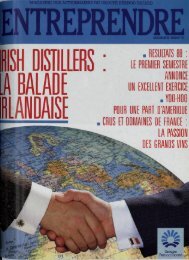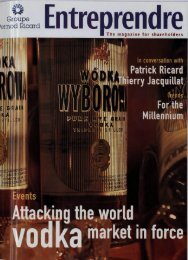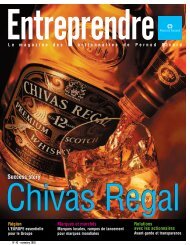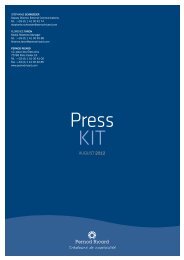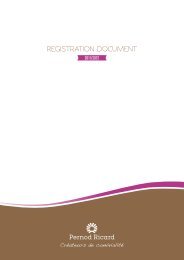Registration Document - Pernod Ricard
Registration Document - Pernod Ricard
Registration Document - Pernod Ricard
You also want an ePaper? Increase the reach of your titles
YUMPU automatically turns print PDFs into web optimized ePapers that Google loves.
3 Risk<br />
66<br />
MANAGEMENT REPORT<br />
factors<br />
Liquidity risk<br />
At 30 June 2009, cash and cash equivalents totalled €520 million. An<br />
additional €1,532 billion of medium-term credit facilities with banks<br />
were confirmed and remained undrawn at this date. Group funding is<br />
provided in the form of long-term debt (syndicated loans, bonds, etc.)<br />
and short-term financing (commercial paper, bank overdrafts, etc. ),<br />
which provide adequate financial resources to ensure the continuity<br />
of its business. N et short-term financial debt was €383 million.<br />
While the Group has not identified any significant short-term cash<br />
requirements other than those pertaining to its recurr ing operations,<br />
it cannot be fully guaranteed that it will be able to continue to get<br />
the funding and refinancing needed for its day-to-day operations<br />
and investments under satisfactory conditions, given the prevailing<br />
economic climate.<br />
In addition, the Group’s bank and bond debt contracts include<br />
covenants. Breaches of these covenants could force the Group to<br />
make accelerated payments. As of 30 June 2009, the Group was in<br />
compliance with the covenants (consolidated EBITDA/net financing<br />
cost and total net debt/consolidated EBITDA) under the terms of its<br />
syndicated loan .<br />
Similarly , while the vast majority of the Group’s cash surplus is placed<br />
with branches of global banks enjoying the highest agency ratings,<br />
it cannot be ruled out that these Group investments may experience<br />
reduced liquidity and severe volatility.<br />
Market risks (currency<br />
and interest rates)<br />
Currency risk<br />
As the Group consolidates its financial statements in euros, it is<br />
exposed to fluctuations against the euro by the currencies in which<br />
its assets and liabilities are denominated (asset risk) or in which<br />
transactions are carried out (transaction risk and translation of<br />
results).<br />
While some hedging strategies allow exposure to be limited, there is<br />
no absolute protection against exchange-rate fluctuations.<br />
For asset risk, financing foreign-currency-denominated assets<br />
acquired by the Group with debt in the same currency provides natural<br />
hedging. This principle was applied for the acquisition of Seagram,<br />
Allied Domecq and Vin&Sprit assets denominated in American dollars<br />
and Japanese yen.<br />
Fluctuations against the euro (particularly by the American dollar)<br />
can have an impact on the nominal amount of debt and the amounts<br />
of interest expense reported in financial statements audited in euros,<br />
thereby deteriorating the Group’s results.<br />
With respect to operational currency risk, its international operations<br />
expose the Group to currency risks bearing on transactions carried<br />
out by subsidiaries in a currency other than their operating currency.<br />
In all cases, it is Group policy to invoice end customers in the<br />
functional currency of the distributing entity. Exposure to exchange-<br />
PERNOD RICARD<br />
rate risk on invoicing between producer and distributor subsidiaries<br />
is managed via a monthly payment centralisation procedure involving<br />
most countries with freely convertible and transferable currencies<br />
and whose internal legislation allows this participation. This system<br />
hedges against net exposure using forward exchange contracts.<br />
Residual risk is partially hedged using financial derivatives (forward<br />
buying, forward selling or options) to hedge certain of highly probable<br />
non-Group operating receivables and payables.<br />
Interest-rate risk<br />
When the syndicated loans for the acquisition of Seagram and Allied<br />
Domecq assets were put in place, the Group exceeded the hedging<br />
obligation required by the banks. The hedging portfolio includes<br />
swaps and interest-rate options in addition to fixed-rate debt.<br />
Additional information on the above risks is provided in Notes 18 –<br />
Financial instruments and 19 – Currency and interest rate derivatives<br />
in the notes to the consolidated financial statements.<br />
Insurance and risk coverage<br />
For <strong>Pernod</strong> <strong>Ricard</strong>, use of insurance is a solution for the financial<br />
transfer of the major risks facing the Group. This transfer is<br />
accompanied by a policy of prevention for the purpose of reducing<br />
contingencies as far as possible. The Group evaluates its risks with<br />
care in order to best adjust the level of coverage of the risks it incurs.<br />
The Group has two types of cover: Group insurance programmes<br />
and local policies. The programmes at Group level are monitored<br />
by an insurance manager who coordinates the insurance and risk<br />
management policy, and also by a person in charge of monitoring<br />
industrial risk prevention.<br />
Insurance policies<br />
In order to cover the main risks, <strong>Pernod</strong> <strong>Ricard</strong> has set up international<br />
insurance programmes for all Group subsidiaries, barring exceptions<br />
due to local regulatory constraints in certain countries or as a result<br />
of more attractive conditions offered by the local market. These<br />
programmes provide the following cover:<br />
◆ property damage and business interruption losses;<br />
◆<br />
operating and product liability;<br />
◆ costs and losses incurred by the Group due to accidental and/or<br />
criminal contamination;<br />
◆ Directors’<br />
civil liability;<br />
◆ damage during transport (and storage);<br />
◆<br />
credit insurance for trade receivables;<br />
◆ fraud.<br />
A number of subsidiaries have taken out additional insurance for<br />
specific needs ( e.g. insurance for vineyards in Australia and Spain,<br />
insurance for vehicle fleets, etc.).<br />
I REFERENCE DOCUMENT 2008/2009 I





